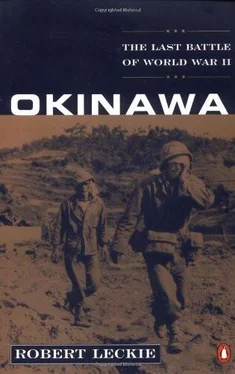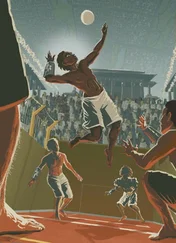But was the straight-ahead, annihilating attack the only solution to the destruction of Ushijima’s remaining sixty thousand men? Tenth Army had already secured and improved all the air and port facilities on Okinawa. For the Japanese, there was no way out, around, under, over, or through. Did no one suggest cutting off the enemy to let him starve? Why not emulate Nimitz’s “island-hopping” strategy in the Pacific, leaving enemy garrisons to “wither on the vine” by seizing the biggest and most useful islands while neutralizing those lying in between by aerial bombing. The Japanese could have been whittled and demoralized by constant aerial, land, and sea bombardment—even goaded into those desperation, back-breaking Banzai attacks so attractive to the Samurai character. Doubtless, they would not remain completely contained but would sally forth in typical night forays aimed at spreading terror and destruction. But this could have only minor success. It could never have inflicted casualties among the Americans comparable to what they suffered in Buckner’s final straight-ahead assault.
Nevertheless, perhaps because of the importunate appeals of Spruance and Turner—who, after all, were his superior officers —General Buckner did quickly schedule another grand offensive for May 11. The Ninety-sixth Division back on line would be on the eastern (or left) flank, the Seventy-seventh on its right; next, First Marine Division, and then the Sixth on the right, or western, flank. General Hodge would command his Twenty-fourth Corps troops on the left and would be the tactical commander of the entire front, with Geiger leading the Third Corps Marines. It was typical of Geiger, whose courtesy matched Buckner’s, that he did not protest the selection of Hodge as tactical chief, even though he was his senior and about to receive his third star.
This offensive was to be a continuation of the others with the same tactics, including the capable General Bruce’s innovation of concentrating on a limited objective from which fire could be brought to bear on the enemy’s reverse slope. Just before the jump-off date, however, the Great Loo Choo’s gray, growling, and moisture-laden sky became the Lord of the Battlefield.
May: Rain, Mud, Blood - and Breakthrough!
CHAPTER TWENTY
On May 7 the skies of the Great Loo Choo opened with prolonged and torrential rains that reminded First Division Leathernecks of the month-long monsoon they had endured in the New Britain campaign. During seventeen days of intermittent storms, some fifteen inches of rain fell on Okinawa.
Nothing could stand against it; a letter from home in the sodden pocket of a GI or Marine had to be read and re-read and memorized before the ink ran and it fell apart in less than a week; a pair of socks lasted no longer; and a pack of cigarettes became watery and uninflammable unless smoked the same day, or else, along with matches, they were kept dry within a contraceptive inside a helmet liner. Pocketknife blades rusted together, and watches recorded the period of their own decay. Rain made garbage of the food; pencils swelled into useless pulp; fountain pens became clogged with watery ink, and their points burst apart; rifle barrels turned blue with mold and had to be slung upside down to keep the raindrops from fouling their bores. Sometimes bullets in the rifle magazines stuck together, while machine gunners had to go over their belts daily, extracting the bullets and oiling them to prevent their sticking to the cloth loops. Everything lay damp and sodden, squishy and squashy to the touch, exuding a steady and musty reek that was the odor of decaying vegetation.
To the Americans out in the open—unlike their enemies warm, dry, and snug in their underground warrens—there were only three things of value to be found in this gurgling, gushing, rushing, streaming, dripping, drenching downpour that turned Okinawa’s numerous narrow and shallow streams into raging, boiling, white torrents of water: a dry place, hot and solid food, and most of all—most unbelievably important of all!—a hot cup of coffee. At sundown before blackout discipline would be in force, among squads huddling together all over the island, tiny fires were made of the wrappings of cigarette packages and the waxed covers of K rations, and water heated in a canteen cup containing grains of K ration soluble coffee—thus were their bellies fortified against another cold black rainy night.
And the rain on Okinawa made Okinawa mud. It was unique because it was everywhere: in the ears, under the nails, inside leggings, or squeezed coarse and cold between the toes. It got into a man’s weapons, it was in his food, and sometimes he could feel it grinding like emery grains between his teeth. Whatever was slotted, pierced, open, or empty received this mud. Wounds also. Men prayed not to get hit while rain fell and made mud. It embarrassed drivers of bulldozers and made pick-and-shovel coolies of those lordly tank troops. Some days it denied Americans the use of roads altogether, and GIs and Marines on the attack again often had to be supplied by airdrop. Frequently it was hardly possible to walk in it. A few strides and a man’s shoes were coated and heavy with mud. Two more and they seemed as though encased in lead. A third step and it was easier to slip out of them before the mud sucked them off and walk in it bare-footed. Engineers on the airfields actually put their shoes aside and worked in sacking drawn over their feet and tied around the knees.
It was this mud in which the entire Tenth Army lay immobilized on the eighth of May, the day on which smeared and dripping Marines and GIs received the splendid news that Germany had surrendered.
“So what?” they snorted in contempt.
The death of Hitler and the destruction of his Third Reich meant about as much to these embattled Americans as the pardon of one condemned criminal might mean to another still under sentence of death. General Ushijima and the stubborn soldiers of his Thirty-second Army were their only concern, and at that very moment Ushijima was taking advantage of the rain that had stalled his enemy to strengthen his flanks while his artillerists reminded their foe that the air still sang and shrieked with invisible death. Ushijima also reinforced the strongpoints guarding the vital forty-foot-wide east-west highway behind his barrier line, settling down to that grim step-for-step war of attrition urged on him by Colonel Yahara. Because of these defenses—and the incessant rain—the Tenth Army drive southward on May 9 moved even slower.
At the same time, the kikusui scourging of the invasion fleet rose to a crescendo of fury. Opposing them were those Marine Corsair pilots from Yontan and Kadena who had come to the Great Loo Choo expecting to fly close-up support of the ground Leathernecks, only to be called to the rescue of the radar picket ships. They rode the suiciders down to unintended destruction away from their target vessels, sometimes even after the American pilots had expended all their ammunition. A few of them attacked the kamikaze and baka with their whirling propellers, just as Lieutenant Robert Klingman did in the bizarre Battle of the Frozen Guns.
That was the dogfight fought at over 40,000 feet among a Japanese two-seater Nick fighter and two Corsairs piloted by Klingman and Captain Kenneth Reusser. On combat air patrol over Ie Shima on May 10 they spotted the vapor trail of the Japanese at 25,000 feet. They chased him, climbing steadily from 10,000 altitude until, after a pursuit of 185 miles, firing off most of their ammunition to lighten their load, they caught up with the Nick at 38,000 feet.
They closed.
Reusser shot up all his ammunition in damaging the Japanese’s left wing and left engine. Klingman bored in to within 50 feet and pressed his gun button. His guns were frozen. He drove in, his propellers whirling. They chopped up the enemy’s rudder and left it dangling. In the Nick’s rear cockpit the gunner was banging his fists on his own frozen guns. The Corsair’s big propellers chewed on. Klingman turned and came back for another pass. He cut off the rudder and loosened the right stabilizer. He was running out of gas. He decided he didn’t have enough to make Okinawa anyway and turned for a third pass. He cut off the Nick’s stabilizer. The plane went into a spin, and at 15,000 feet it lost both wings and plunged into the East China Sea.
Читать дальше










